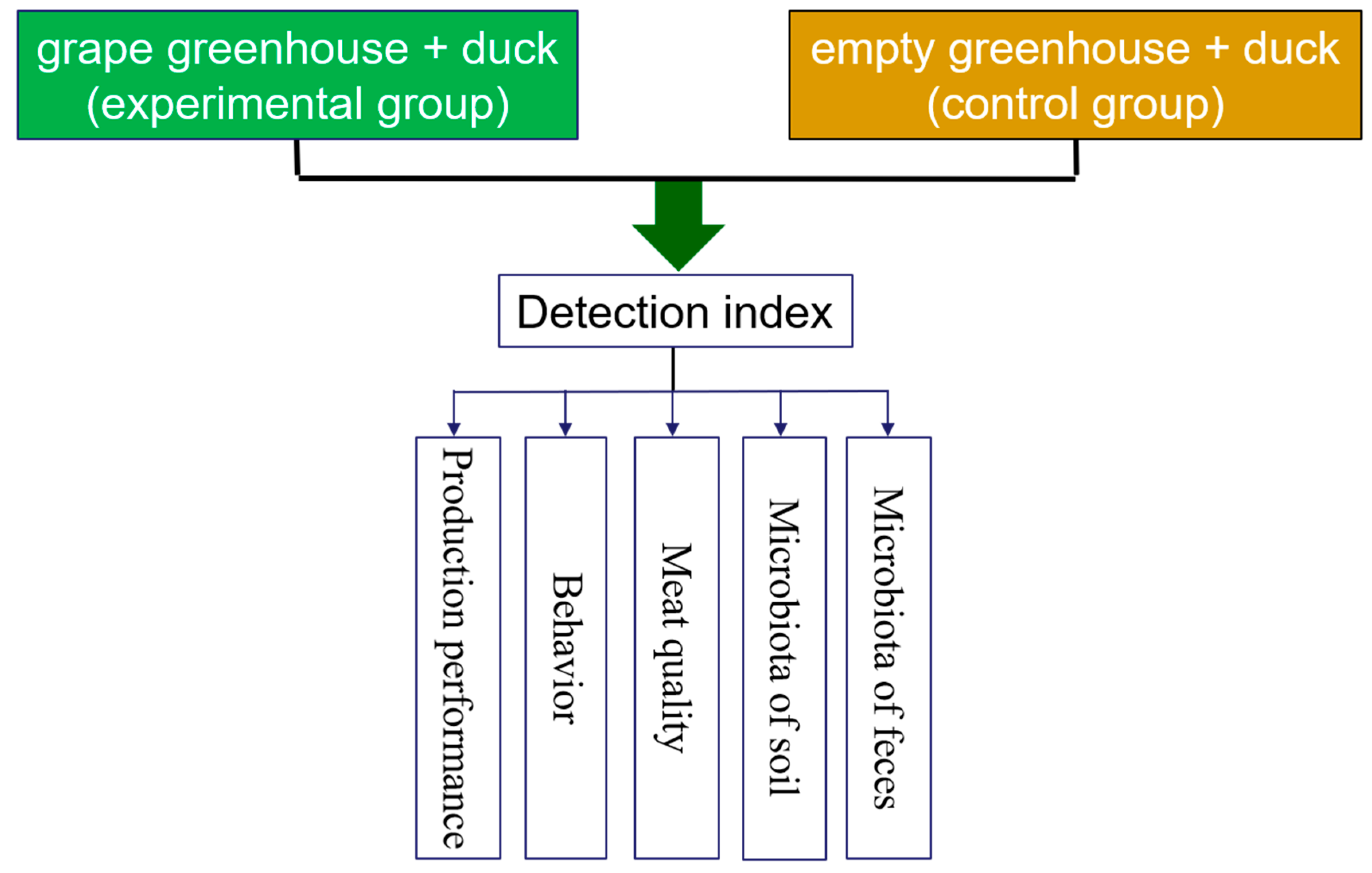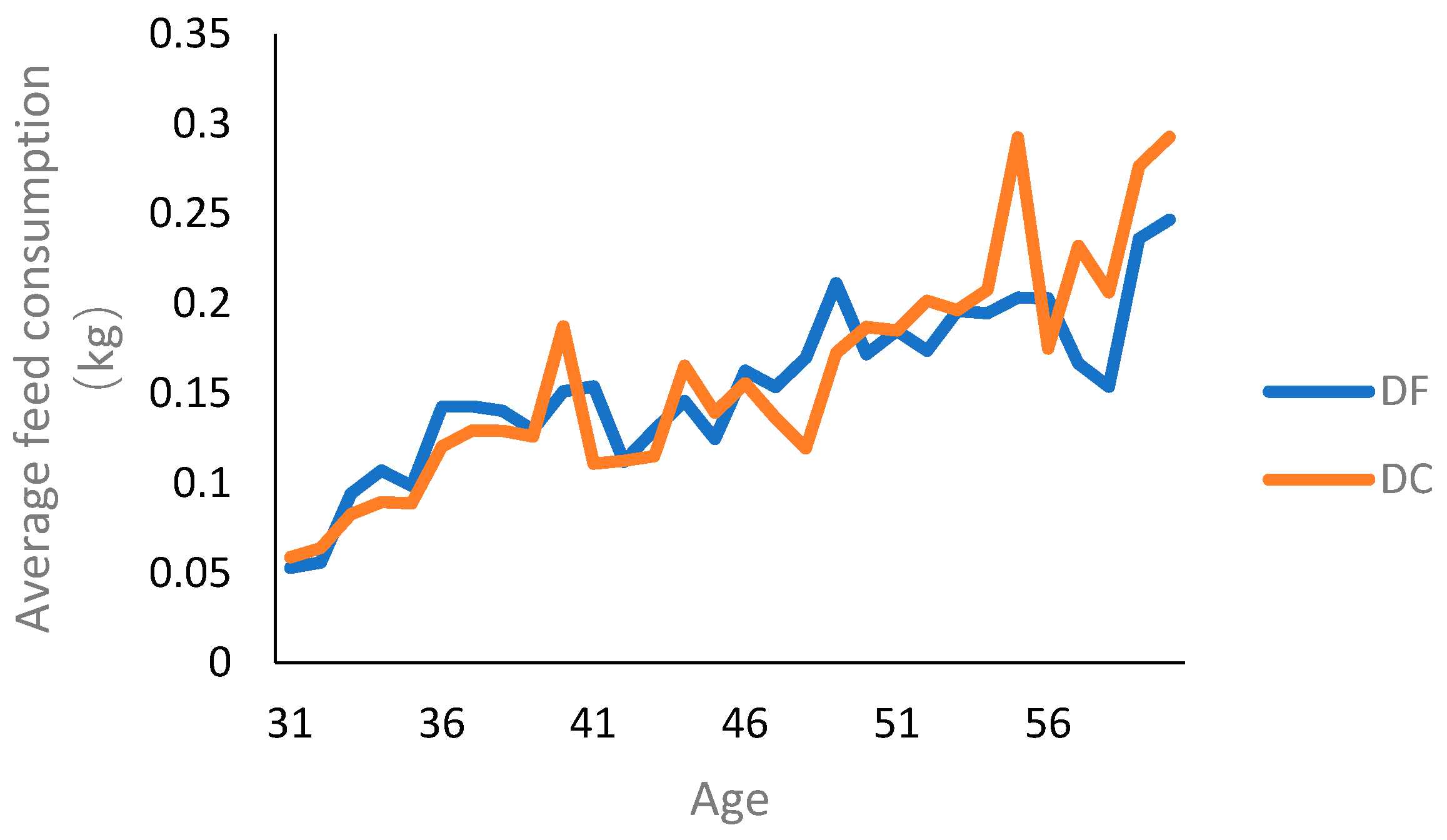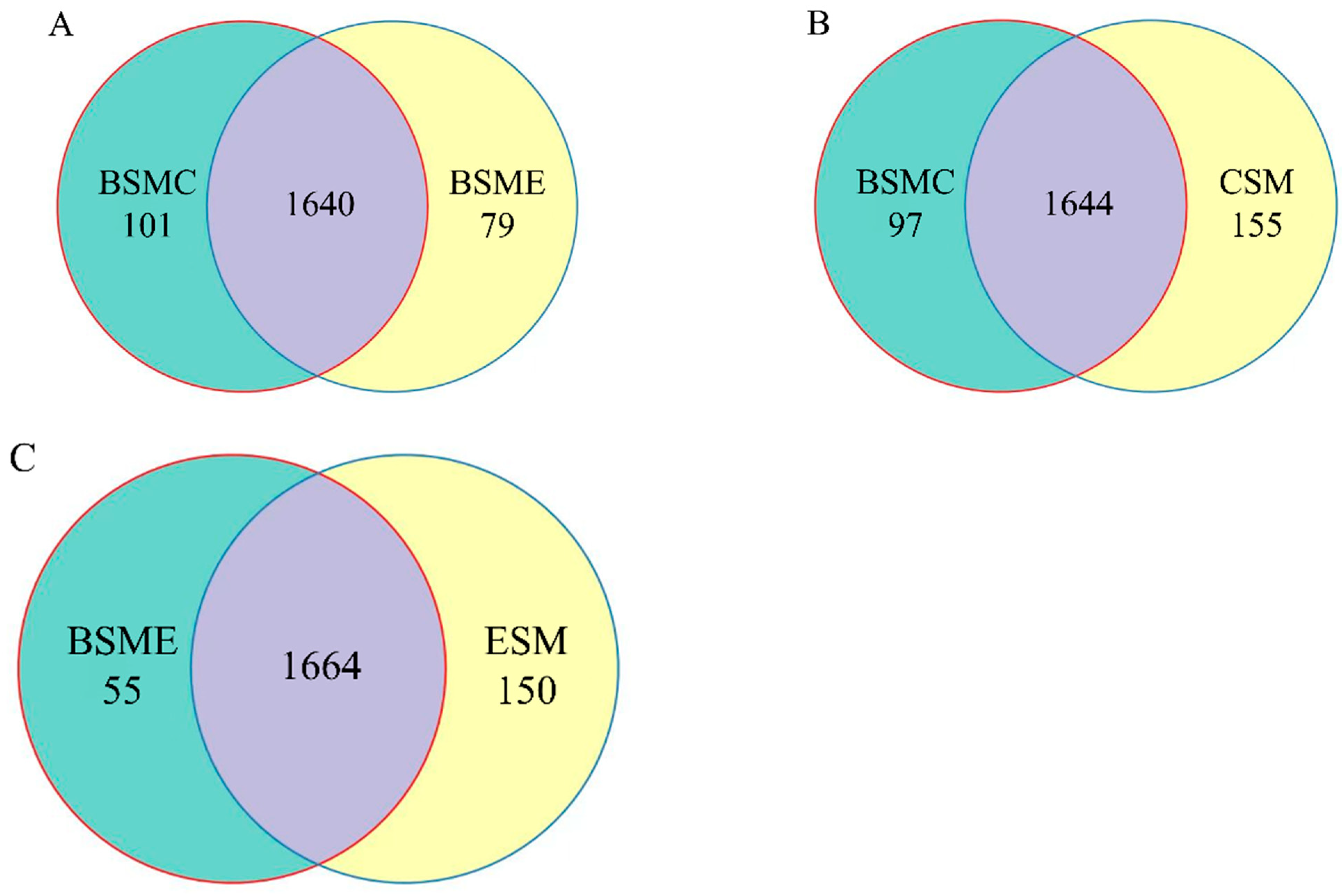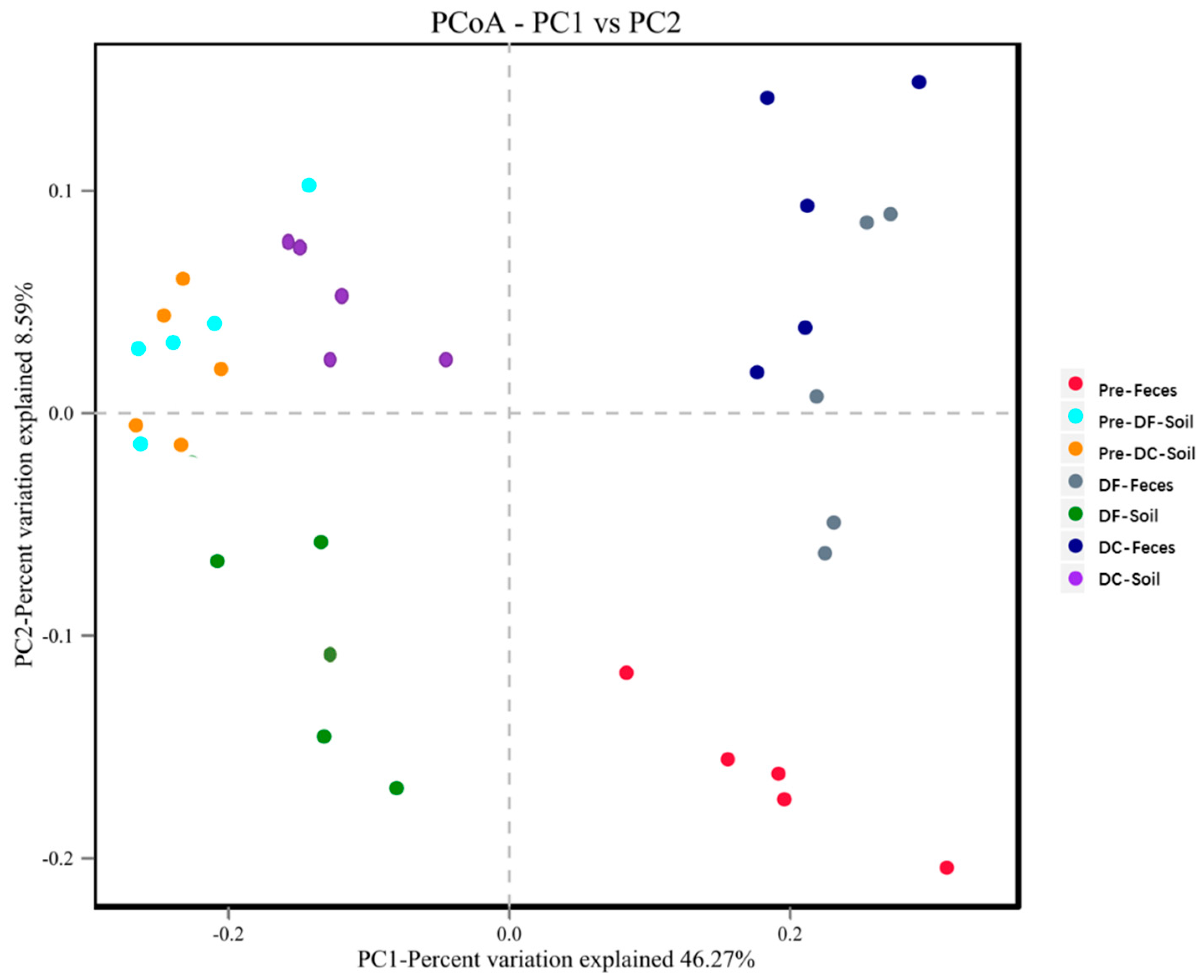Integration of Grape-Duck Production Pattern Boosts Duck Behavior, Meat Quality, Fecal Microbiota and Soil Microorganisms
Abstract
1. Introduction
2. Materials and Methods
2.1. Experimental Design Descriptions
2.2. Behavioral Observations
2.3. Meat Quality of Ducks
2.4. Microbial Analysis of Soil and Fecal Samplings
3. Results
3.1. Production Performance
3.1.1. Survival Rate
3.1.2. Feed Consumption
3.1.3. Body Weight
3.1.4. Slaughter Performance
3.2. Behaviors
3.3. Meat Quality
3.4. Effects on Microbiota of Soil and Duck Feces
3.4.1. Soil Microbial Composition
Raw Data Processing and Quality Control
OTU Analysis
Alpha Diversity
Microbial Relative Abundance Analysis in Soils
3.5. Duck Feces Microbial Composition
3.5.1. Raw Data Quality Control and Processing
3.5.2. OTU Analysis
3.5.3. Alpha Diversity Analysis Indices
3.5.4. Relative Abundance of Microbial Composition in Feces
3.6. Beta Diversity Analysis
4. Discussion
4.1. Effects of Duck Behaviors
4.2. Effects on Production and Slaughter Performance of Ducks
4.3. Effects on Ducks’ Meat Quality
4.4. Effects on Microorganisms in Soil and Duck Feces
5. Conclusions
Author Contributions
Funding
Institutional Review Board Statement
Data Availability Statement
Acknowledgments
Conflicts of Interest
References
- Thornton, P. The Emergence of Agriculture: Bruce D. Smith. Scientific American Library, Distributed by W. H. Freeman & Co. Ltd, New York and Oxford, 1995. 231 pp. Price: £19.95, US$ 32.95 (Hardback). ISBN 0 7167 5055 4. 1996; Volume 51, pp. 496–497. Available online: https://www.sciencedirect.com/science/article/abs/pii/0308521X96814892?via%3Dihub (accessed on 29 November 2022).
- Bell, L.W.; Moore, A.D. Integrated crop–livestock systems in Australian agriculture: Trends, drivers and implications. Agric. Syst. 2012, 111, 1–12. [Google Scholar] [CrossRef]
- Faust, D.R.; Kumar, S.; Archer, D.W.; Hendrickson, J.R.; Kronberg, S.L.; Liebig, M.A. Integrated Crop-Livestock Systems and Water Quality in the Northern Great Plains: Review of Current Practices and Future Research Needs. J. Environ. Qual. 2018, 47, 1–15. [Google Scholar] [CrossRef]
- Russelle, M.P.; Entz, M.H.; Franzluebbers, A.J. Reconsidering integrated crop-livestock systems in north America. Agron. J. 2007, 99, 325–334. [Google Scholar] [CrossRef]
- Massaccesi, L.; Cartoni Mancinelli, A.; Mattioli, S.; De Feudis, M.; Castellini, C.; Dal Bosco, A.; Marongiu, M.L.; Agnelli, A. Geese Reared in Vineyard: Soil, Grass and Animals Interaction. Animals 2019, 9, 179. [Google Scholar] [CrossRef] [PubMed]
- Carvalho, P.C.F.; Peterson, C.A.; Nunes, P.A.A.; Martins, A.P.; de Souza Filho, W.; Bertolazi, V.T.; Kunrath, T.R.; de Moraes, A.; Anghinoni, I. Animal production and soil characteristics from integrated crop-livestock systems: Toward sustainable intensification. J. Anim. Sci. 2018, 96, 3513–3525. [Google Scholar] [CrossRef]
- Patrizi, N.; Niccolucci, V.; Castellini, C.; Pulselli, F.M.; Bastianoni, S. Sustainability of agro-livestock integration: Implications and results of Emergy evaluation. Sci. Total Environ. 2018, 622, 1543–1552. [Google Scholar] [CrossRef] [PubMed]
- Cartoni Mancinelli, A.; Mattioli, S.; Menchetti, L.; Dal Bosco, A.; Chiattelli, D.; Angelucci, E.; Castellini, C. Validation of a behavior observation form for geese reared in agroforestry systems. Sci. Rep. 2022, 12, 15152. [Google Scholar] [CrossRef]
- Mancinelli, A.; Mattioli, S.; Bosco, A.; Piottoli, L.; Ranucci, D.; Branciari, R.; Cotozzolo, E.; Castellini, C. Rearing Romagnola geese in vineyard: Pasture and antioxidant intake, performance, carcass and meat quality. Ital. J. Anim. Sci. 2019, 18, 1–9. [Google Scholar] [CrossRef]
- Chen, K.; Gao, Y.; Wang, Z.; Wang, Y.; Zhang, X. Performance Ferms and Measurement for Poultry; China Agriculture Press: Beijing, China, 2004. [Google Scholar]
- Bokulich, N.A.; Subramanian, S.; Faith, J.J.; Gevers, D.; Gordon, J.I.; Knight, R.; Mills, D.A.; Caporaso, J.G. Quality-filtering vastly improves diversity estimates from Illumina amplicon sequencing. Nat. Methods 2013, 10, 57–59. [Google Scholar] [CrossRef]
- Jones, T.A.; Dawkins, M.S. Effect of environment on Pekin duck behaviour and its correlation with body condition on commercial farms in the UK. Br. Poult. Sci. 2010, 51, 319–325. [Google Scholar] [CrossRef]
- Wang, Y.; Wang, Y.; Wang, B.; Mei, X.; Jiang, S.; Li, W. Protocatechuic acid improved growth performance, meat quality, and intestinal health of Chinese yellow-feathered broilers. Poult. Sci. 2019, 98, 3138–3149. [Google Scholar] [CrossRef] [PubMed]
- Bhandari, D.K.; Sharma, J.C.; Dahiya, S.S.; Dhankar, J.S. Collection and preparation of soil samples. Environ. Sci. 2004, 37–45. [Google Scholar]
- Dennis, K.L.; Wang, Y.; Blatner, N.R.; Wang, S.; Saadalla, A.; Trudeau, E.; Roers, A.; Weaver, C.T.; Lee, J.J.; Gilbert, J.A.; et al. Adenomatous Polyps Are Driven by Microbe-Instigated Focal Inflammation and Are Controlled by IL-10-Producing T Cells. Cancer Res. 2013, 73, 5905–5913. [Google Scholar] [CrossRef]
- Bolger, A.M.; Lohse, M.; Usadel, B. Trimmomatic: A flexible trimmer for Illumina sequence data. Bioinformatics 2014, 30, 2114–2120. [Google Scholar] [CrossRef] [PubMed]
- Martin, M. Cutadapt removes adapter sequences from high-throughput sequencing reads. EMBnet J. 2011, 17, 10–12. [Google Scholar] [CrossRef]
- Magoc, T.; Salzberg, S.L. FLASH: Fast length adjustment of short reads to improve genome assemblies. Bioinformatics 2011, 27, 2957–2963. [Google Scholar] [CrossRef] [PubMed]
- Edgar, R.C.; Haas, B.J.; Clemente, J.C.; Quince, C.; Knight, R. UCHIME improves sensitivity and speed of chimera detection. Bioinformatics 2011, 27, 2194–2200. [Google Scholar] [CrossRef]
- Edgar, R.C. UPARSE: Highly accurate OTU sequences from microbial amplicon reads. Nat. Methods 2013, 10, 996–998. [Google Scholar] [CrossRef]
- Quast, C.; Pruesse, E.; Yilmaz, P.; Gerken, J.; Schweer, T.; Yarza, P.; Peplies, J.; Glockner, F.O. The SILVA ribosomal RNA gene database project: Improved data processing and web-based tools. Nucleic Acids Res. 2013, 41, D590–D596. [Google Scholar] [CrossRef]
- Nilsson, R.H.; Larsson, K.-H.; Taylor, A.F.S.; Bengtsson-Palme, J.; Jeppesen, T.S.; Schigel, D.; Kennedy, P.; Picard, K.; Gloeckner, F.O.; Tedersoo, L.; et al. The UNITE database for molecular identification of fungi: Handling dark taxa and parallel taxonomic classifications. Nucleic Acids Res. 2019, 47, D259–D264. [Google Scholar] [CrossRef]
- Lawley, B.; Tannock, G.W. Analysis of 16S rRNA Gene Amplicon Sequences Using the QIIME Software Package. In Oral Biology: Molecular Techniques and Applications, 2nd ed.; Seymour, G.J., Cullinan, M.P., Heng, N.C.K., Eds.; Humana Press: New York, NY, USA, 2017; Volume 1537, pp. 153–163. [Google Scholar]
- Rai, S.N.; Qian, C.; Pan, J.; Rai, J.P.; Song, M.; Bagaitkar, J.; Merchant, M.; Cave, M.; Egilmez, N.K.; McClain, C.J. Microbiome data analysis with applications to pre-clinical studies using QIIME2: Statistical considerations. Genes Dis. 2021, 8, 215–223. [Google Scholar] [CrossRef] [PubMed]
- Dawkins, M.S. Behavioral deprivation—A central problem in animal-welfare. Appl. Anim. Behav. Sci. 1988, 20, 209–225. [Google Scholar] [CrossRef]
- Dawkins, M.S.; Donnelly, C.A.; Jones, T.A. Chicken welfare is influenced more by housing conditions than by stocking density. Nature 2004, 427, 342–344. [Google Scholar] [CrossRef] [PubMed]
- Tanaka, T.; Ozaki, T.; Watanabe, T.; Tanida, H.; Yoshimoto, T. Effects of Perches on Behavior and Performance of Caged Hens. Jpn. Poult. Sci. 2008, 30, 183–189. [Google Scholar] [CrossRef]
- Liao, S.C.; Lyu, P.X.; Shen, S.Y.; Hsiao, C.C.; Lien, C.Y.; Wang, S.D.; Lin, T.Y.; Tu, P.A. Effects of Swimming Pool Conditions and Floor Types on White Roman Geese’s Physical Condition Scores and Behaviors in an Indoor Rearing System. Animals 2022, 12, 3273. [Google Scholar] [CrossRef]
- Colton, S.; Fraley, G.S. The effects of environmental enrichment devices on feather picking in commercially housed Pekin ducks. Poult. Sci. 2014, 93, 2143–2150. [Google Scholar] [CrossRef] [PubMed]
- Savory, C.J.; Gentle, M.J.; Yeomans, M.R. Opioid modulation of feeding and drinking in fowls. Br. Poult. Sci. 1989, 30, 379–392. [Google Scholar] [CrossRef]
- Riber, A.B.; Wichman, A.; Braastad, B.O.; Forkman, B. Effects of broody hens on perch use, ground pecking, feather pecking and cannibalism in domestic fowl (Gallus gallus domesticus). Appl. Anim. Behav. Sci. 2007, 106, 39–51. [Google Scholar] [CrossRef]
- Massuquetto, A.; Panisson, J.C.; Marx, F.O.; Surek, D.; Krabbe, E.L.; Maiorka, A. Effect of pelleting and different feeding programs on growth performance, carcass yield, and nutrient digestibility in broiler chickens. Poult. Sci. 2019, 98, 5497–5503. [Google Scholar] [CrossRef]
- Ju, X.; Shu, J.; Zhang, M.; Liu, Y.; Tu, Y.; Ji, G.; Shan, Y.; Zou, J. Comparison analysis of meat quality and flavor of different breeds and feeding periods of broilers. Chin. J. Anim. Nutr. 2018, 30, 2421–2430. [Google Scholar]
- Castillo, A.; Schiavone, A.; Cappai, M.G.; Nery, J.; Gariglio, M.; Sartore, S.; Franzoni, A.; Marzoni, M. Performance of Slow-Growing Male Muscovy Ducks Exposed to Different Dietary Levels of Quebracho Tannin. Animals 2020, 10, 979. [Google Scholar] [CrossRef]
- Jung, D.Y.; Lee, D.; Lee, H.J.; Kim, H.-J.; Jung, J.H.; Jang, A.; Jo, C. Comparison of chicken breast quality characteristics and metabolites due to different rearing environments and refrigerated storage. Poult. Sci. 2022, 101, 101953. [Google Scholar] [CrossRef]
- Owens, C.M.; Hirschler, E.M.; Mckee, S.R.; Martinez-Dawson, R.; Sams, A.R. The characterization and incidence of pale, soft, exudative turkey meat in a commercial plant 1. Poult. Sci. 2000, 79, 553–558. [Google Scholar] [CrossRef]
- Juqing, W.U.; Chunbao, L.I.; Guanghong, Z.; Xinglian, X.U.; Xiuxiang, J.U.; Yichen, C. Changes of Meat Color and Tenderness of Chilled Beef and Pork during Postmortem Aging. Food Sci. 2008, 29, 136–139. [Google Scholar]
- He, F.; Wang, Z.; Zhang, C.; Ge, C.; Zhang, D. Effect of Drip Loss of Lamb from Different Varieties on the Meat Quality. J. Chin. Inst. Food Sci. Technol. 2018, 18, 239–247. [Google Scholar]
- Castellini, C.; Mugnai, C.; Bosco, A.D.J.J.o.M.F.; Medicine, N. Effect of conventional versus organic method of production on the broiler carcass and meat quality. Meat Sci. 2002, 60, 219–225. [Google Scholar] [CrossRef] [PubMed]
- Allen, C.D.; Fletcher, D.L.; Northcutt, J.K.; Russell, S.M. The relationship of broiler breast color to meat quality and shelf-life. Poult. Sci. 1998, 77, 361–366. [Google Scholar] [CrossRef] [PubMed]
- Mueller, U.G.; Sachs, J.L. Engineering Microbiomes to Improve Plant and Animal Health. Trends Microbiol. 2015, 23, 606–617. [Google Scholar] [CrossRef]
- Phour, M.; Sehrawat, A.; Sindhu, S.S.; Glick, B.R. Interkingdom signaling in plant-rhizomicrobiome interactions for sustainable agriculture. Microbiol. Res. 2020, 241, 126589. [Google Scholar] [CrossRef] [PubMed]
- Lau, J.A.; Lennon, J.T. Rapid responses of soil microorganisms improve plant fitness in novel environments. Proc. Natl. Acad. Sci. USA 2012, 109, 14058–14062. [Google Scholar] [CrossRef]
- Xun, W.; Yan, R.; Ren, Y.; Jin, D.; Xiong, W.; Zhang, G.; Cui, Z.; Xin, X.; Zhang, R. Grazing-induced microbiome alterations drive soil organic carbon turnover and productivity in meadow steppe. Microbiome 2018, 6, 170. [Google Scholar] [CrossRef] [PubMed]
- Wang, F.; Kong, W.; Ji, M.; Zhao, K.; Chen, H.; Yue, L.; Dong, X. Grazing greatly reduces the temporal stability of soil cellulolytic fungal community in a steppe on the Tibetan Plateau. J. Environ. Sci. 2022, 121, 48–57. [Google Scholar] [CrossRef]
- Dai, J.; Tian, P.; Zhang, Y.; Su, J.Y. Rhizobacteria community structure and diversity of six salt-tolerant plants in Yinbei saline soil. Acta Ecol. Sin. 2019, 39, 2705–2714. [Google Scholar]
- Yang, Y.; Xu, M.; Zou, X.; Chen, J.; Zhang, J.; Zhang, J. Effects of different vegetation types on the characteristics of soil bacterial communities in the hilly area of central Guizhou. J. Ecol. Rural Environ. 2021, 37, 518–525. [Google Scholar] [CrossRef]
- Watts, D.B.; Torbert, H.A.; Feng, Y.; Prior, S.A. Soil Microbial Community Dynamics as Influenced by Composted Dairy Manure, Soil Properties, and Landscape Position. Soil Sci. 2010, 175, 474–486. [Google Scholar] [CrossRef]
- Sun, R.; Zhang, X.-X.; Guo, X.; Wang, D.; Chu, H. Bacterial diversity in soils subjected to long-term chemical fertilization can be more stably maintained with the addition of livestock manure than wheat straw. Soil Biol. Biochem. 2015, 88, 9–18. [Google Scholar] [CrossRef]
- Yan, W.; Sun, C.; Zheng, J.; Wen, C.; Ji, C.; Zhang, D.; Chen, Y.; Hou, Z.; Yang, N. Efficacy of Fecal Sampling as a Gut Proxy in the Study of Chicken Gut Microbiota. Front. Microbiol. 2019, 10, 2126. [Google Scholar] [CrossRef]
- Zhou, X.; Jiang, X.; Yang, C.; Ma, B.; Lei, C.; Xu, C.; Zhang, A.; Yang, X.; Xiong, Q.; Zhang, P.; et al. Cecal microbiota of Tibetan Chickens from five geographic regions were determined by 16S rRNA sequencing. Microbiologyopen 2016, 5, 753–762. [Google Scholar] [CrossRef]
- Li, J.-P.; Wu, Q.-F.; Ma, S.-C.; Wang, J.-M.; Wei, B.; Xi, Y.; Han, C.-C.; Li, L.; He, H.; Liu, H.-H. Effect of feed restriction on the intestinal microbial community structure of growing ducks. Arch. Microbiol. 2022, 204, 85. [Google Scholar] [CrossRef]
- Wang, J.-M.; Gan, X.-M.; Pu, F.-J.; Wang, W.-X.; Ma, M.; Sun, L.-L.; Hu, J.-W.; Hu, B.; Zhang, R.-P.; Bai, L.-L.; et al. Effect of fermentation bed on bacterial growth in the fermentation mattress material and cecum of ducks. Arch. Microbiol. 2021, 203, 1489–1497. [Google Scholar] [CrossRef]








| Behavior | Behavior Definition |
|---|---|
| Forage | Exploring in search of food |
| Feed | Eating food |
| Drink | Drinking from the water source |
| Swallow | Food entering the stomach through the pharynx and esophagus |
| Stand | Standing stationary |
| Walk | Locomotion; the number of strides were also counted |
| Rest | Lying down with eyes closed |
| Groom | One duck dry-preening another duck |
| Aggressive | Head reaching out, pecking behavior towards another duck |
| Stereotypic | Highly repetitive behavior of no apparent purpose and significance |
| Feather peck | Attacking nearby peers, tearing their feathers |
| Day Age | DF | DC | p-Value |
|---|---|---|---|
| 31 | 256.20 ± 68.36 | 258.44 ± 63.52 | 0.87 |
| 38 | 424.89 ± 111.39 | 364.79 ± 89.99 | 0.01 |
| 45 | 618.56 ± 158.19 | 486.04 ± 91.26 | 2.37 × 10−6 |
| 52 | 794.04 ± 202.59 | 545.39 ± 138.28 | 3.37 × 10−10 |
| 59 | 896.58 ± 224.47 | 671.00 ± 166.67 | 2.21 × 10−7 |
| Detection Index | DF | DC | p-Value |
|---|---|---|---|
| Slaughter weight (g) | 1082.80 ± 101.56 | 952.40 ± 123.43 | 0.11 |
| Dressed weight (g) | 979.20 ± 101.96 | 857.40 ± 108.71 | 0.11 |
| Half-eviscerated weight (g) | 916.60 ± 111.11 | 782.60 ± 93.53 | 0.07 |
| Eviscerated weight (g) | 816.60 ± 121.19 | 693.60 ± 90.22 | 0.11 |
| Leg muscle weight (g) | 208.60 ± 31.53 | 177.40 ± 63.34 | 0.35 |
| Dressed percentage (%) | 90.60 ± 6.54 | 90.30 ± 7.91 | 0.96 |
| Percentage of half-eviscerated yield (%) | 84.90 ± 9.31 | 83.30 ± 13.42 | 0.83 |
| Percentage of leg muscle (%) | 25.60 ± 1.92 | 35.30 ± 28.12 | 0.46 |
| Detection Index | DF | DC | p-Value |
|---|---|---|---|
| L* | 42.69 ± 1.70 | 47.91 ± 7.45 | 0.17 |
| a* | 10.04 ± 3.52 | 10.65 ± 4.63 | 0.82 |
| b* | 2.62 ± 1.16 | 4.30 ± 0.91 | 0.03 |
| pH | 6.38 ± 0.13 | 6.28 ± 0.10 | 0.19 |
| Drip loss (%) | 1.80 ± 0.61 | 3.80 ± 1.72 | 0.04 |
| Cooking loss (%) | 8.70 ± 50.42 | 9.10 ± 2.83 | 0.87 |
| Shear force (N) | 24.99 ± 5.06 | 40.08 ± 15.10 | 0.07 |
| Groups | p-Value | ||||
|---|---|---|---|---|---|
| BSMC | BSME | CSM | ESM | ||
| ACE | 1421.56 | 1413.15 | 1514.00 | 1558.16 | 0.02 |
| Chao1 | 1449.53 | 1454.31 | 1531.86 | 1930.06 | 0.06 |
| Simpson | 0.99 | 0.99 | 0.99 | 0.99 | 0.81 |
| Shannon | 8.69 | 8.83 | 7.48 | 8.90 | 0.65 |
| PD_whole | 74.51 | 76.24 | 79.40 | 77.09 | 0.41 |
| Good_coverage | 0.99 | 0.99 | 0.99 | 0.99 | 0.25 |
| Sample ID | p-Value | |||
|---|---|---|---|---|
| BFM | CFM | EFM | ||
| Feature | 616.00 | 636.00 | 614.00 | 0.88 |
| ACE | 679.02 | 716.27 | 719.07 | 0.26 |
| Chao1 | 691.08 | 719.37 | 729.35 | 0.38 |
| Simpson | 0.81 | 0.83 | 0.88 | 0.93 |
| Shannon | 4.82 | 4.58 | 5.30 | 0.85 |
| PD_whole | 38.94 | 40.92 | 39.81 | 0.47 |
| Good_coverage | 0.99 | 0.99 | 0.99 | 0.36 |
Disclaimer/Publisher’s Note: The statements, opinions and data contained in all publications are solely those of the individual author(s) and contributor(s) and not of MDPI and/or the editor(s). MDPI and/or the editor(s) disclaim responsibility for any injury to people or property resulting from any ideas, methods, instructions or products referred to in the content. |
© 2023 by the authors. Licensee MDPI, Basel, Switzerland. This article is an open access article distributed under the terms and conditions of the Creative Commons Attribution (CC BY) license (https://creativecommons.org/licenses/by/4.0/).
Share and Cite
Zhou, Y.; Yan, C.; Chen, D.; Zhang, C.; Zhao, X. Integration of Grape-Duck Production Pattern Boosts Duck Behavior, Meat Quality, Fecal Microbiota and Soil Microorganisms. Agriculture 2023, 13, 218. https://doi.org/10.3390/agriculture13010218
Zhou Y, Yan C, Chen D, Zhang C, Zhao X. Integration of Grape-Duck Production Pattern Boosts Duck Behavior, Meat Quality, Fecal Microbiota and Soil Microorganisms. Agriculture. 2023; 13(1):218. https://doi.org/10.3390/agriculture13010218
Chicago/Turabian StyleZhou, Ye, Chao Yan, Di Chen, Chengde Zhang, and Xingbo Zhao. 2023. "Integration of Grape-Duck Production Pattern Boosts Duck Behavior, Meat Quality, Fecal Microbiota and Soil Microorganisms" Agriculture 13, no. 1: 218. https://doi.org/10.3390/agriculture13010218
APA StyleZhou, Y., Yan, C., Chen, D., Zhang, C., & Zhao, X. (2023). Integration of Grape-Duck Production Pattern Boosts Duck Behavior, Meat Quality, Fecal Microbiota and Soil Microorganisms. Agriculture, 13(1), 218. https://doi.org/10.3390/agriculture13010218





